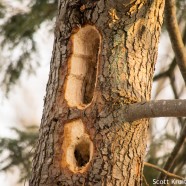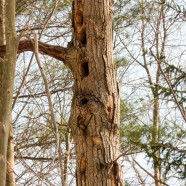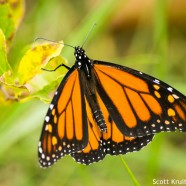Pileated Woodpecker Holes
These are some extra fresh Pileated Woodpecker holes! That wood looks like it has been cut very recently, and it certainly looks like a professional job. Whenever you see a dead or dying tree in your yard please try to leave it there if possible – if it is not infected with something such as Hemlock Woolly Adelgid, or a particularly dangerous falling hazard to people. It will end up serving a host of species that depend on these decaying plants for food, shelter and nesting. Cutting even these trees down solely for aesthetic purposes is robbing the environment of a vital component....
Read MorePileated Woodpecker Signs
Here is another telltale bird sign that you can find rather easily in the winter. Any guesses as to what species made these massive marks on this tree? The Pileated Woodpecker is a large, crow-size bird and as such it creates astonishingly huge holes with its big bill. Even though they are conspicuous birds when seen they can be tough to find in the first place because they have such large territories. If you cannot see them flashing by through mature woodlands try listening for their laughing call or finding these reminders of their presence.
Read MoreMale Cardinal Liftoff
Here’s liftoff of a male Northern Cardinal during a recent snowfall. Get out there this weekend and enjoy the snowy world, Chautauqua County! We will see you on the trails of our glistening landscape.
Read MoreMorning-glory Plume Moth (Emmelina monodactyla)
This looks to be a Morning-glory Plume Moth (Emmelina monodactyla), one that I photographed only last week. Even as we enter November and have already experienced frosts, freezes and early season snowfall in the Northeast (and the Southeast?!) there are still a wide variety of flying insects to be found. Many of our tiny neighbors can be discovered year-round. It only takes a little more effort on our part to spot them. Put on an extra layer if you need it but get outside as much as you can. Scott Kruitbosch Conservation & Outreach Coordinator
Read MoreMigrant Monarch
Today I was thrilled to see several dozen Monarch butterflies as I surveyed a classic fall migration spot on the Connecticut coast. While this total may far under historic sums seen there it is still better than the last couple of years. This male, sexed by the black patches on the hind wings, was one of the more cooperatives individuals. I’ll share more photos of them all week. What are your Monarch counts looking like? Scott Kruitbosch Conservation & Outreach Coordinator
Read More








